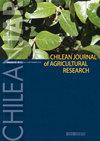Morpho-chemical characterization of Huanglongbing in mandarin (Citrus reticulata) and orange (Citrus sinensis) varieties from Pakistan
IF 1.7
4区 农林科学
Q2 Agricultural and Biological Sciences
引用次数: 2
Abstract
Huanglongbing (HLB) is one of the world’s worst diseases of citrus trees. The research was conducted to characterize positive citrus samples of two local varieties, ‘Kinnow’ mandarin ( Citrus reticulata Blanco) and ‘Mosambi’ orange ( C. sinensis (L.) Osbeck), based on morphological, physical and biochemical characters. Physical and biochemical parameters of greening infected and healthy samples of both the cultivars were significantly different. Citrus fruits were lopsided and half to full green in the HLB infected trees compared to healthy. The HLB infected leaves samples were small and narrow. Fruit diameter, leaf area, and juice weight of HLB infected samples were significantly less than healthy samples. The rind thickness of infected fruits (70% and 80%) was significantly higher than healthy ones (20% and 30%). Starch content of leaves from mandarin (5.54 μg mL -1 ) and orange (6.12 μg mL -1 ) were significantly higher in HLB infected plants, while juice percentage of HLB infected fruit samples was lesser in mandarin and orange (22.73%, and 14.70%, respectively) than healthy fruits (38.22% and 31.30%, respectively). Acidity was significantly increased in juice of HLB infected mandarin and orange fruits (0.57%, and 0.53%, respectively). Similarly, there was significant reduction in biochemical parameters; total sugars in mandarin and orange (5.16% and 4.79%), total soluble solids (8.54% and 8.28%), total chlorophyll (13.50 and 14.92 mg mL -1 ) and ascorbic acid (34.28% and 34.12%) in HLB infected samples of both cultivars. This study determined differences of physical and biochemical parameters of two local citrus varieties, commonly cultivated in the Asian region.巴基斯坦柑桔(Citrus reticulata)和柑桔(Citrus sinensis)品种黄龙冰的形态化学特征
本文章由计算机程序翻译,如有差异,请以英文原文为准。
求助全文
约1分钟内获得全文
求助全文
来源期刊
CiteScore
3.00
自引率
11.80%
发文量
60
审稿时长
6 months
期刊介绍:
ChileanJAR publishes original Research Articles, Scientific Notes and Reviews of agriculture, multidisciplinary and agronomy: plant production, plant protection, genetic resources and biotechnology, water management, soil sciences, environment, agricultural economics, and animal production (focused in ruminant feeding). The editorial process is a double-blind peer reviewing, Editorial Office checks format, composition, and completeness, which is a requirement to continue the editorial process. Editorial Committee and Reviewers evaluate relevance and scientific merit of manuscript.

 求助内容:
求助内容: 应助结果提醒方式:
应助结果提醒方式:


